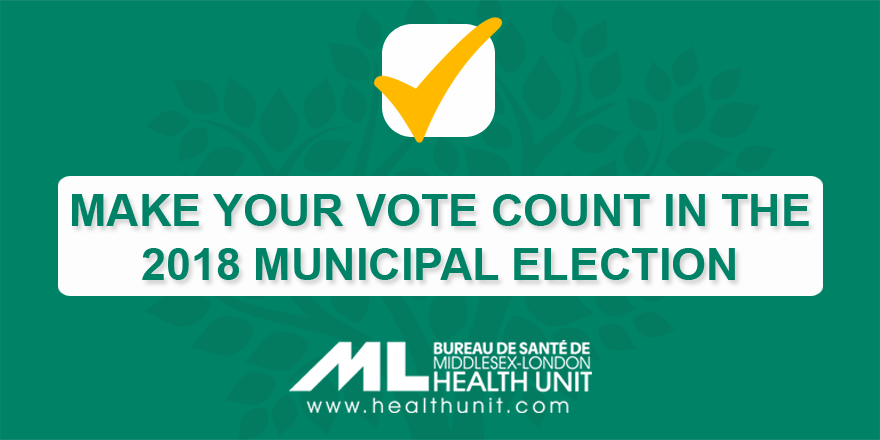Municipal councils play an important role in influencing the health of individuals and communities. Policies and decisions made by municipal councils can impact the social and physical conditions of our world. Private industry, community organizations, and government can work together to build healthy, vibrant and inclusive communities. We depend upon our elected officials to make decisions that will improve the health of our community and citizens.
The municipal election date of October 22 is quickly approaching, but even if you are a first time voter or are choosing to vote for the first time, you have time to ask questions and to think about how decisions made by municipal councils can impact your lives.

Are You Ready for October 22nd?
Every 4 years, voters across Ontario decide who will represent their interests and lead their communities by electing the members of their municipal councils and school boards. The Province of Ontario sets out common rules that all voters and candidates must follow. Every municipality is responsible for conducting elections to their council and for conducting the election of school trustees to Ontario’s school boards. To review these provincial standards, check out the 2018 Voters' Guide for Ontario Municipal Council and School Board Elections.
For Information about the Election in your Community:
- The Township of Adelaide Metcalfe
- The City of London
- The Township of Lucan Biddulph
- The Municipality of Middlesex Centre
- The Town of Newbury
- The Township of North Middlesex
- The Municipality of Southwest Middlesex
- The Municipality of Strathroy Caradoc
- The Municipality of Thames Centre
How Can You Make Your Vote Count in the 2018 Municipal Election?
Municipal Councils make many decisions about local programs and services, and sets policy that affect our health. The social determinants of health (e.g., income, housing, education, social inclusion) are impacted by policies and decisions made by municipal councils, who promote health equity by ensuring all have a fair chance to reach their full health potential without being disadvantaged by social, economic and environmental conditions beyond their control.
Between now and the municipal election on October 22, learn about candidate positions on public health issues that are of importance to you and make the most of your opportunity to cast a ballot.
Resources to Help You to Make an Informed Decision
Healthy People, Healthy Communities
The Middlesex-London Health Unit has compiled a quick guide with questions that can be used to ensure the impact on health is considered when making decisions about the issues our communities face.
alPHa’s Public Health Issues of Concern for the 2018 Municipal Election
The Association of Local Public Health Agencies (alPHa) compiled a package of key messages and public health policy priorities, including:
Ontario Dietitians in Public Health (ODPH) No Money for Food is Cent$less - Call for Action
ODPH profile the issue of food insecurity – not having enough money to buy food – and explain why income solutions, such as a basic income guarantee, a living wage and social assistance rates geared to the real cost of living are needed.
Sustain Ontario: The Alliance for Healthy Food and Farming
Municipalities are key players in Ontario's food system. Consider championing some of the Good Food and Farming Ideas, each accompanied with Issues and Evidence, to provide voters and candidates with resources on how to support food and farming.
Pillar Nonprofit Network - 2018 City of London Municipal Candidates
Pillar Nonprofit Network asked candidates running for municipal office in the City of London to answer questions around inclusion and equity. See what the candidates had to say about what equity and inclusion means to them, and how they plan to demonstrate that these issues are of priority.
Healthy Community Design and Active Transportation
Healthy community design involves the planning and design of communities that make it easier for people of all ages and abilities to live healthy, active and safe lifestyles. The design of neighbourhood streets, buildings and facilities can influence everyday transportation choices. The plan and design of a healthy community can decrease the risks and costs of preventable diseases, injuries, and fatalities as well as support social inclusion.